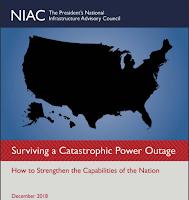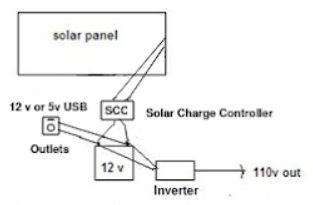
#17,618
For most Americans, the most common emergency they are likely to face is a prolonged power outage, due to hurricanes, blizzards, and other natural disasters. Most of the time, it is an inconvenience, but sometimes it can be life threatening.
- At least 246 people died during Winter Storm Uri in 2021, when the power grid went down in Texas.
- In 2017, Puerto Rico was without power for months following Hurricane Maria, which undoubtedly contributed to the excess mortality there following the storm (see NEJM Mortality in Puerto Rico after Hurricane Maria).
- A few weeks earlier, Hurricane Irma left millions of Floridians without electrical power for days. According to press reports, at least a dozen people died due to heat-related complications at one Florida nursing home.
- In late June of 2012 a Derecho swept across the Eastern United States – killing 15 people – and leaving millions without electrical power (see Picking Up The Pieces). The region remained under an EHE (Extreme Heat Event) advisory for two weeks, leading to at least 32 additional heat-related deaths (see MMWR: Heat-Related Deaths During an Extreme Heat Event).
In December of 2018, in NIAC: Surviving A Catastrophic Power Outage, we looked at a NIAC (National Infrastructure Advisory Council) 94-page report that examined the United State's current ability to respond to and recover from a widespread catastrophic power outage.
A year earlier, in DHS: NIAC Cyber Threat Report - August 2017, we looked at a similar report addressing urgent cyber threats to our critical infrastructure that called for `bold, decisive actions'.
It relied upon a pair of 40 watt solar panels I bought in the early 1990s, and a couple of small (35 amp/hr) lead acid batteries. The panels still work, but are approaching the end of their life, and lead-acid batteries - while cheap - are heavy, have a short (2-4 year life), and can only be discharged about 50% without damage.
Since they are still serviceable, I haven't replaced them, but I have augmented them with a third (50 amp/hr) LiFePo battery (light, long lasting, and able to discharge > 80%), and a new 100 watt solar panel.
This new single battery/panel will charge faster, and deliver more power, than the two other batteries combined. And I did it for roughly $300.
If you are at all handy, and comfortable working with 12 volt DC systems, you should be able to cobble together your own system.
Disclaimer: lead acid batteries can offgas Hydrogen, which can be explosive, and should be kept in a ventilated are. A dead short across the terminals of a 12 volt battery can cause a fire or explosion. Reversing the polarity of your connections can fry components. If you are unsure of how to safely deal with batteries or DC voltage, have someone who knows how assist you.
Admittedly, for many people the best solution may be dropping $500-$1000 on a solar generator (really, a battery-inverter), and $150-$400 on a matching solar panel. Its a plug-and-play solution that can be set up by just about anyone, and they certainly are far more aesthetically pleasing than a home brew setup.
But if something breaks, you usually have to send it back to the factory for repairs. That turnaround time might be weeks. No matter how good the warranty, it's of limited comfort when the power is already out.
A home brew system, by its very nature, makes it possible for you to repair it yourself. Except for the cables, a typical system has between 3 and 5 components; Solar panel, Solar Charge Controller, and battery. For more versatility you can add a 12v/5v USB outlet, and (if desired) a 110v inverter.
For systems of this size, 110v inverters have limited value. They drain a battery very quickly, and while I have a couple (100 watt & 400 watt), I honestly have a hard time thinking of where I would use them. Charging a laptop, perhaps.
Still, this may be adequate for a lot of people. The advantage is, everything is plug and play, relatively inexpensive, will fit into a duffel bag, and you can start small and add components at your own pace.
As for my new system, it looks like this:
The solar panel is about 18" wide & 39" long. The battery, LiFePo solar charge controller, and output devices all fit into a plastic crate, and weigh about 12 lbs. It provides dual 12V Car Cigarette Lighter Sockets (for CPAP, or Inverter), 2 USB outlets, and the ability to expand.Major Parts list:
- ECO-WORTHY 12V 50Ah Trolling Motor LiFePO4 $160
- 100 Watt 12 v Monocrystalline Solar Panel $70
- Solar Charge Controller 10A, Bateria 12V/24V $18
- 12V 3A LiFePO4 Battery Charger $20
- Misc cabling and connectors $20
So, what did my (roughly) $300 upgrade add?
- With 40-45 amps available from the LiFePo battery I can run my CPAP for 5 (8 hour) nights without recharging. Or, I can watch 35-40 hours of DVDs, or run a large 12 volt fan for 40+ hours. I can also use it to recharge smaller USB battery banks, run 12 volt lights, radios, etc.
- With a 100 watt Solar panel, I can probably average 5+ amps an hour charging, for 4 to 7 hours a day. On on good day, I could probably recharge the battery from being 80% discharged.
I've also invested $10 into a lead-acid trickle wall charger (110 v) and a $20 3 amp LiFePo wall charger (110 v), so I can keep batteries fully charged when the power is on, without having to deploy the solar panels.
Having this solar gear won't guarantee I'll come away unscathed from the next hurricane, or natural disaster. But, along with having a propane camp stove and heater, a decent first aid kit, 60 gallons of water stored, a well stocked pantry, and a disaster buddy . . . it should certainly improve my odds.





